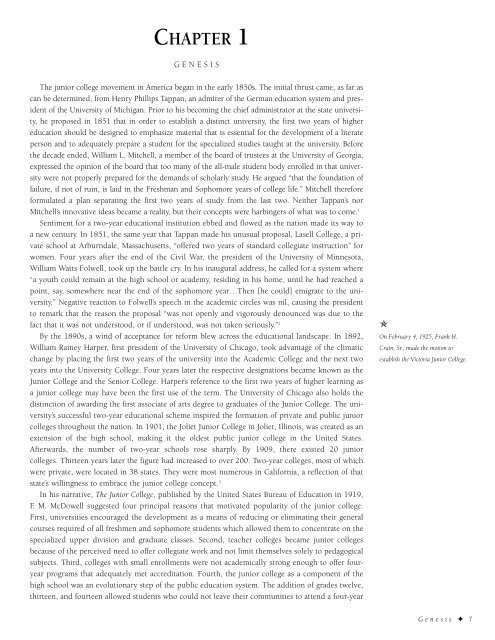The Victoria College, 1925-2000: A Tradition of Excellence
A history of the Victoria College of Victoria, Texas, published to commemorate the institution's 75th anniversary.
A history of the Victoria College of Victoria, Texas, published to commemorate the institution's 75th anniversary.
- No tags were found...
Create successful ePaper yourself
Turn your PDF publications into a flip-book with our unique Google optimized e-Paper software.
CHAPTER 1<br />
GENESIS<br />
<strong>The</strong> junior college movement in America began in the early 1850s. <strong>The</strong> initial thrust came, as far as<br />
can be determined, from Henry Phillips Tappan, an admirer <strong>of</strong> the German education system and president<br />
<strong>of</strong> the University <strong>of</strong> Michigan. Prior to his becoming the chief administrator at the state university,<br />
he proposed in 1851 that in order to establish a distinct university, the first two years <strong>of</strong> higher<br />
education should be designed to emphasize material that is essential for the development <strong>of</strong> a literate<br />
person and to adequately prepare a student for the specialized studies taught at the university. Before<br />
the decade ended, William L. Mitchell, a member <strong>of</strong> the board <strong>of</strong> trustees at the University <strong>of</strong> Georgia,<br />
expressed the opinion <strong>of</strong> the board that too many <strong>of</strong> the all-male student body enrolled in that university<br />
were not properly prepared for the demands <strong>of</strong> scholarly study. He argued “that the foundation <strong>of</strong><br />
failure, if not <strong>of</strong> ruin, is laid in the Freshman and Sophomore years <strong>of</strong> college life.” Mitchell therefore<br />
formulated a plan separating the first two years <strong>of</strong> study from the last two. Neither Tappan’s nor<br />
Mitchell’s innovative ideas became a reality, but their concepts were harbingers <strong>of</strong> what was to come. 1<br />
Sentiment for a two-year educational institution ebbed and flowed as the nation made its way to<br />
a new century. In 1851, the same year that Tappan made his unusual proposal, Lasell <strong>College</strong>, a private<br />
school at Arburndale, Massachusetts, “<strong>of</strong>fered two years <strong>of</strong> standard collegiate instruction” for<br />
women. Four years after the end <strong>of</strong> the Civil War, the president <strong>of</strong> the University <strong>of</strong> Minnesota,<br />
William Watts Folwell, took up the battle cry. In his inaugural address, he called for a system where<br />
“a youth could remain at the high school or academy, residing in his home, until he had reached a<br />
point, say, somewhere near the end <strong>of</strong> the sophomore year…<strong>The</strong>n [he could] emigrate to the university.”<br />
Negative reaction to Folwell’s speech in the academic circles was nil, causing the president<br />
to remark that the reason the proposal “was not openly and vigorously denounced was due to the<br />
fact that it was not understood, or if understood, was not taken seriously.” 2<br />
By the 1890s, a wind <strong>of</strong> acceptance for reform blew across the educational landscape. In 1892,<br />
William Rainey Harper, first president <strong>of</strong> the University <strong>of</strong> Chicago, took advantage <strong>of</strong> the climatic<br />
change by placing the first two years <strong>of</strong> the university into the Academic <strong>College</strong> and the next two<br />
years into the University <strong>College</strong>. Four years later the respective designations became known as the<br />
Junior <strong>College</strong> and the Senior <strong>College</strong>. Harper’s reference to the first two years <strong>of</strong> higher learning as<br />
a junior college may have been the first use <strong>of</strong> the term. <strong>The</strong> University <strong>of</strong> Chicago also holds the<br />
distinction <strong>of</strong> awarding the first associate <strong>of</strong> arts degree to graduates <strong>of</strong> the Junior <strong>College</strong>. <strong>The</strong> university’s<br />
successful two-year educational scheme inspired the formation <strong>of</strong> private and public junior<br />
colleges throughout the nation. In 1901, the Joliet Junior <strong>College</strong> in Joliet, Illinois, was created as an<br />
extension <strong>of</strong> the high school, making it the oldest public junior college in the United States.<br />
Afterwards, the number <strong>of</strong> two-year schools rose sharply. By 1909, there existed 20 junior<br />
colleges. Thirteen years later the figure had increased to over 200. Two-year colleges, most <strong>of</strong> which<br />
were private, were located in 38 states. <strong>The</strong>y were most numerous in California, a reflection <strong>of</strong> that<br />
state’s willingness to embrace the junior college concept. 3<br />
In his narrative, <strong>The</strong> Junior <strong>College</strong>, published by the United States Bureau <strong>of</strong> Education in 1919,<br />
F. M. McDowell suggested four principal reasons that motivated popularity <strong>of</strong> the junior college.<br />
First, universities encouraged the development as a means <strong>of</strong> reducing or eliminating their general<br />
courses required <strong>of</strong> all freshmen and sophomore students which allowed them to concentrate on the<br />
specialized upper division and graduate classes. Second, teacher colleges became junior colleges<br />
because <strong>of</strong> the perceived need to <strong>of</strong>fer collegiate work and not limit themselves solely to pedagogical<br />
subjects. Third, colleges with small enrollments were not academically strong enough to <strong>of</strong>fer fouryear<br />
programs that adequately met accreditation. Fourth, the junior college as a component <strong>of</strong> the<br />
high school was an evolutionary step <strong>of</strong> the public education system. <strong>The</strong> addition <strong>of</strong> grades twelve,<br />
thirteen, and fourteen allowed students who could not leave their communities to attend a four-year<br />
✯<br />
On February 4, <strong>1925</strong>, Frank H.<br />
Crain, Sr., made the motion to<br />
establish the <strong>Victoria</strong> Junior <strong>College</strong>.<br />
Genesis ✦ 7















